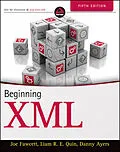A complete update covering the many advances to the XML
language
The XML language has become the standard for writing documents
on the Internet and is constantly improving and evolving. This new
edition covers all the many new XML-based technologies that have
appeared since the previous edition four years ago, providing you
with an up-to-date introductory guide and reference. Packed with
real-world code examples, best practices, and in-depth coverage of
the most important and relevant topics, this authoritative resource
explores both the advantages and disadvantages of XML and addresses
the most current standards and uses of XML.
* Features the most updated content built on audience feedback
from the previous edition as well as the vast knowledge from XML
developer teams
* Boasts new chapters on RELAX NG and Schematron, XML
functionality in databases, LINQ to XML, Jabber and XMLPP, XHTML,
HTML5, and more
* Offers in-depth coverage on extracting data from XML and
updated material on Web Services
Beginning XML, Fifth Edition delivers the most important
aspects of XML in regard to what it is, how it works, what
technologies surround it, and how it can best be used in a variety
of situations.
Autorentext
Joe Fawcett is the head of software at Kaplan Financial
and was one of the first Microsoft MVPs for XML.
Liam R. E. Quin is the W3C XML Activity Lead and Staff
Contact for the XML Query Working Group, and the XSL-FO subgroup of
the XSL Working Group.
Danny Ayers works for Talis on applications for their
hosted semantic web platform.
Zusammenfassung
A complete update covering the many advances to the XML language
The XML language has become the standard for writing documents on the Internet and is constantly improving and evolving. This new edition covers all the many new XML-based technologies that have appeared since the previous edition four years ago, providing you with an up-to-date introductory guide and reference. Packed with real-world code examples, best practices, and in-depth coverage of the most important and relevant topics, this authoritative resource explores both the advantages and disadvantages of XML and addresses the most current standards and uses of XML.
- Features the most updated content built on audience feedback from the previous edition as well as the vast knowledge from XML developer teams
- Boasts new chapters on RELAX NG and Schematron, XML functionality in databases, LINQ to XML, Jabber and XMLPP, XHTML, HTML5, and more
- Offers in-depth coverage on extracting data from XML and updated material on Web Services
Beginning XML, Fifth Edition delivers the most important aspects of XML in regard to what it is, how it works, what technologies surround it, and how it can best be used in a variety of situations.
Inhalt
Introduction xxvii
Part I: Introducing XML
Chapter 1: What is XML? 3
Steps Leading up to XML: Data Representation and Markups 4
The Birth of XML 6
More Advantages of XML 10
XML in Practice 13
Summary 23
Chapter 2: Well-Formed XML 25
What Does Well-Formed Mean? 26
Creating XML in a Text Editor 26
Advanced XML Parsing 40
The XML Infoset 47
Summary 50
Chapter 3: XML Namespaces 53
Defining Namespaces 54
Why Do You Need Namespaces? 54
How Do You Choose a Namespace? 56
How to Declare a Namespace 58
Namespace Usage in the Real World 68
When to Use and Not Use Namespaces 72
Common Namespaces 75
Summary 78
Part II: Validation
Chapter 4: Document Type Definitions 83
What Are Document Type Definitions? 83
Anatomy of a DTD 93
DTD Limitations 114
Summary 114
Chapter 5: XML Schemas 117
Benefits of XML Schemas 118
XML Schemas in Practice 120
Defining XML Schemas 124
Creating a Schema from Multiple Documents 161
Documenting XML Schemas 167
XML Schema 1.1 170
Summary 171
Chapter 6: RELAX NG and Schematron 175
Why Do You Need More Ways of Validating XML? 176
Setting Up Your Environment 176
Using RELAX NG 177
Using Schematron 193
Summary 207
Part III: Processing
Chapter 7: Extracting Data from XML 211
Document Models: Representing XML in Memory 211
The XPath Language 216
Summary 236
Chapter 8: XSLT 239
How Is XSLT a Functional Language? 242
Setting Up Your XSLT Development Environment 242
Foundational XSLT Elements 245
Reusing Code in XSLT 276
Understanding Built-In Templates and Built-In Rules 282
Using XSLT 2.0 284
XSLT and XPath 3.0: What's Coming Next? 302
Summary 303
Part IV: Databases
Chapter 9: XQuery 307
XQuery, XPath, and XSLT 308
XQuery in Practice 309
Building Blocks of XQuery 313
The Anatomy of a Query Expression 318
Some Optional XQuery Features 332
Coming in XQuery 3.0 333
Summary 338
Chapter 10: XML and Databases 341
Understanding Why Databases Need to Handle XML 341
Analyzing which XML Features are Needed in a Database 343
Using MySQL with XML 345
Using SQL Server with XML 355
Using eXist with XML 386
Summary 399
Part V: Programming
Chapter 11: Event-Driven Programming 403
Understanding Sequential Processing 404
Using SAX in Sequential Processing 404
Using XmlReader 434
Summary 448
Chapter 12: LINQ to XML 451
What Is LINQ? 451
Creating Documents 457
Extracting Data from an XML Document 461
Modifying Documents 468
Transforming Documents 472
Using VB.NET XML Features 474
Summary 480
Part VI: Communication
Chapter 13: RSS, Atom, and Content Syndication 485
Syndication 485
Working with News Feeds 501
A Simple Aggregator 502
Transforming RSS with XSLT 524
Useful Resources 534
Summary 535
Chapter 14: Web Services 539
What Is an RPC? 539
RPC Protocols 541
The New RPC Protocol: Web Services 543
<...